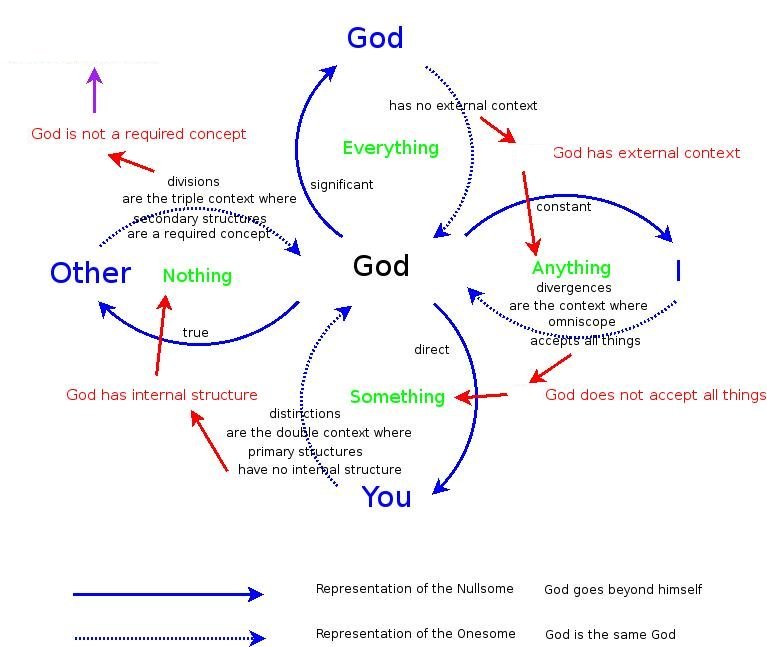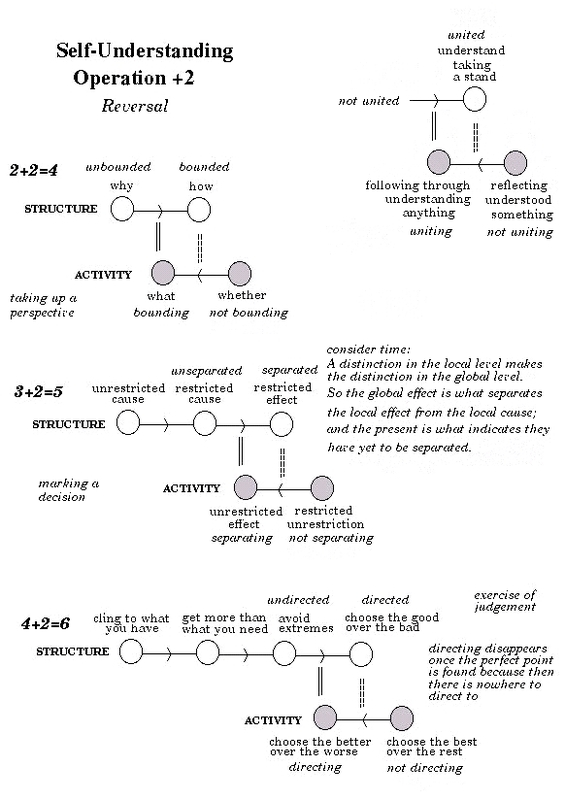Mintys.IrDu istorija
Paslėpti nežymius pakeitimus - Rodyti kodo pakeitimus
Veiksmai, Padalinimų ratas, Veiksmas +1, Veiksmas +3
Žr. iš ankščiau: Self-understanding, Heart, Definition, SelfDescription, StateTransitionSyntax, Fractal
Veiksmai, Padalinimų ratas, Veiksmas +1, Veiksmas +3, Veikla, Žmogaus savęs suvokimas, Širdis, Apibrėžimas
Žr. iš ankščiau: SelfDescription, StateTransitionSyntax, Fractal
http://www.ms.lt/en/andrius/understanding/diagrams/operationplus2.jpg
http://www.ms.lt/en/andrius/understanding/diagrams/operationplus2.jpg
Atkūrimas
Kas yra atkūrimas
- Atkūrimas yra būtinumo klausimas: Ar būtų jeigu nebūtų?
- Dievo požiūris yra vienumas, o žmogaus požiūris yra atkūrimas.
- Atkūrimas yra vienumo buvimo prielaidos.
Koks yra atkūrimas
- Atkūrimas yra sąmoningas vienumas. Tad atkūrimas yra trejybinis, jame glūdi dvejybė ir vienybė, jisai prisiima ir tveria žmogaus požiūrį.
- Atkūrimas yra trejybinis.
- Atkuriama tai, kas yra, tam, kam atrodo.
- Atkūrimas, kaip toks, neigia vienumą. Visgi, atkūrimas vienumą naujai patvirtina.
Kaip atkuriama
- Asmeniui atkuriama požiūriu.
- Atkuriama vienumo pagrindais, tuo kas yra - asmeniu, kitu, Dievu, ir tuo kas nėra - požiūriu, bendryste, meile.
- Kam nors (asmeniui) atrodo, tad yra asmens apimtyje, apimties nurodytame tarpe.
- Knygos yra svarbios nes jomis atkuriame žinias. Kalba taipogi svarbi. Minčių atkūrimas, sugrįžimas prie jų, yra savarankiško mąstymo pradžia, nes tai leidžia pasirinkti, ar dėmesį skirti naujom mintim ar ankstyvesnėm mintim.
Kodėl atkuriama
- Tai, kas yra, yra už tarpo, o tas, kam atrodo, susitelkęs į tarpą, į būklę. Tikslas yra tam, kam atrodo.
- Kaip veiksmas +2 veikia padalinimus? Kaip suvokti lygtis 0+2=2, 1+2=3, 2+2=4, 3+2=5 ir taip toliau?
- What is NullStructure and NullActivity and what does it mean to negate them? How does Negation introduce or reintroduce Scope? How is Negation basic to Understanding?
- How can we add a NullStructure to Understanding and then remove a NullActivity?
Žr. Veiksmai, Padalinimų ratas
Kaip veiksmas +2 lygtimis išreiškia sąmonę?
- I need to show how the Sevensome arises from the Sixsome.
- I need to interpret the perspectives of the [{{Representations}} of the sixsome] as part of the [{{Eightfold}} way]
- I need to show how the structure of the {{Counterquestions}} arises from the {{Omniscope}}
- I need to show how the structure of the [{{Directions}} from the good] and the [{{Directions}} to the good] arises from the {{Omniscope}}
- I should try to relate {{Observer}} and {{Observed}} to the [{{Anti}} structure] equations [{{{{Six}} add two}} 6 +2 =0] and [{{{{Seven}} add two}} 7 +2 = 1].
- Kaip nulinis veiksmas ("null activity") susijęs su nieko nedarymu - identiniu morfizmu ("do nothing action") Yoneda lemoje?
Nuline veikla
Nulinė veikla yra:
- the lack of assumptions. Activity within a System of doing nothing, which is identified with what is beyond System, and thereby is the going from within a System to beyond the System.
- pasikartojanti veikla
- nulybės veikla, joks dalinimas
- Aštuntasis požiūris
- susikalbėjimo pagrindas
- Visaregyje:
- zero going-beyond-oneself
- zero-divergence, that which is inherent at its own stage
- zero-distinction, that being (I) which coincides with its nature (You)
- zero-division - nulybėje, joks dalinimas
A statement in the system can always include the "null activity" even if it is not able to refer to the "total structure", but the two are the same (?)
Užrašai
- Įsijausti, atsitokėti - veikia ir veidrodinis dėsnis - aš įsijaučiu, tu įsijauti, aš atsitokėju, tu atsitokėji, ir taip pirmyn atgal.
Savęs įtraukimas į padalinimą.
Veiksmą +2 suprantu kaip savęs įtraukimą (self-inclusion) į padalinimą.
===ChristopherLangan===
{{Andrius}}: ChristopherLangan writes of SelfInclusion, and I think that is an analogue to my operation [AddOne +2] which relates {{Structure}} and {{Activity}} (or for him, {{Time}} and {{Space}}.
He calls this conspansion and relates it to the speed of light and space time.
[http://www.megafoundation.org/CTMU/Articles/IntroCTMU.htm Introduction to the CTMU]: An act is a temporal process, and self-inclusion is a spatial relation. The act of self-inclusion is thus "where time becomes space"; for the set of all sets, there can be no more fundamental process. No matter what else happens in the evolving universe, it must be temporally embedded in this dualistic self-inclusion operation. In the CTMU, the self-inclusion process is known as conspansion and occurs at the distributed, Lorentz-invariant conspansion rate c, a time-space conversion factor already familiar as the speed of light in vacuo (conspansion consists of two alternative phases accounting for the wave and particle properties of matter and affording a logical explanation for accelerating cosmic expansion). When we imagine a dynamic self-including set, we think of a set growing larger and larger in order to engulf itself from without. But since there is no "without" relative to the real universe, external growth or reference is not an option; there can be no external set or external descriptor. Instead, self-inclusion and self-description must occur inwardly as the universe stratifies into a temporal sequence of states, each state topologically and computationally contained in the one preceding it (where the conventionally limited term computation is understood to refer to a more powerful SCSPL-based concept, protocomputation, involving spatiotemporal parallelism). On the present level of discourse, this inward self-inclusion is the conspansive basis of what we call spacetime.
{{Andrius}}: I think that this self-inclusion is the same as what I call the operation [AddTwo +2] which adds two perspectives to a division of everything.
Original source: [http://ming.tv/flemming2.php/__show_article/_a000010-000243.htm Stable non-destructive self embedding], 2002-11-12, by FlemmingFunch
[http://www.soulinvitation.com/indexdw.html Dan Winter] is a sacred geometry genius. He speaks and writes a mile a minute and I can't exactly follow most of what he's saying. But some of it intuitively makes great sense. One thing he often talks about is self embedding, and there's a point there which I think is very important. I can't grasp the math, so bear with my more simplistic and possibly naive version.
Multiple waves can co-exist in the same space, if they're in {{harmony}}, so to speak. If they're not in harmony they might sort of collide, but under certain circumstances the waves all sort of fit into the same space. Multiple harmonics form a unified tone. Multiple waves form one wave form which represents all of them at once.
Potentially you can pack a lot of information into a very small place if it all embeds into each other. It can travel together in a very compact form. And you can reverse it and get it all back again. So, it is non-destructive.
Fractals fit in here. A very simple recursive formula might produce something very complex. The complexity is embedded into itself in the form of a simplicity, so to speak.
Now, metaphysically or spiritually speaking, that might have something to do with self-awareness and with eternal life. If you can embed all that you are into itself in a non-destructive way, you can go through the eye of the needle, and remain intact and conscious even if you travel to another universe. Through a black hole, say.
And the point I wanted to get to here right now is that a group of diverse people with diverse talents might function well as a group if the characteristics of the members embed well into each other. Or, reversely, if they can all function as variations of the same fractal principle. There's a harmony that might take place, which isn't agreement per se. It is more that everything sort of fits together in a very economical way.
If you come in during the day and I come in during the night, we can fit in the same office. If I get a lot of mail from foreign lands, and you collect stamps, and another person recycles paper, it all fits together. If I walk across a chasm, I don't really need a 20,000 ton bridge - I just need something under my foot in the exact place where I put it at any given moment. Am I making any sense?
- James: Tender minded (materialist, step-in) - tough minded (idealist, step-out) - truth of world and heart? Solve with pragmatism.
William James: Tender minded (materialist, step-in) - tough minded (idealist, step-out) - truth of world and heart? Solve with pragmatism.
Original source: [http://ming.tv/flemming2.php/__show_article/_a000010-000243.htm Stable non-destructive self embedding], 2002-11-12, by FlemmingFunch
Flemming Funch: [http://www.soulinvitation.com/indexdw.html Dan Winter] is a sacred geometry genius. He speaks and writes a mile a minute and I can't exactly follow most of what he's saying. But some of it intuitively makes great sense. One thing he often talks about is self embedding, and there's a point there which I think is very important. I can't grasp the math, so bear with my more simplistic and possibly naive version.
Multiple waves can co-exist in the same space, if they're in {{harmony}}, so to speak. If they're not in harmony they might sort of collide, but under certain circumstances the waves all sort of fit into the same space. Multiple harmonics form a unified tone. Multiple waves form one wave form which represents all of them at once.
Potentially you can pack a lot of information into a very small place if it all embeds into each other. It can travel together in a very compact form. And you can reverse it and get it all back again. So, it is non-destructive.
Fractals fit in here. A very simple recursive formula might produce something very complex. The complexity is embedded into itself in the form of a simplicity, so to speak.
Now, metaphysically or spiritually speaking, that might have something to do with self-awareness and with eternal life. If you can embed all that you are into itself in a non-destructive way, you can go through the eye of the needle, and remain intact and conscious even if you travel to another universe. Through a black hole, say.
And the point I wanted to get to here right now is that a group of diverse people with diverse talents might function well as a group if the characteristics of the members embed well into each other. Or, reversely, if they can all function as variations of the same fractal principle. There's a harmony that might take place, which isn't agreement per se. It is more that everything sort of fits together in a very economical way.
If you come in during the day and I come in during the night, we can fit in the same office. If I get a lot of mail from foreign lands, and you collect stamps, and another person recycles paper, it all fits together. If I walk across a chasm, I don't really need a 20,000 ton bridge - I just need something under my foot in the exact place where I put it at any given moment. Am I making any sense?
Christopher Langan sąvoka "conspansion" sieja erdvę ir laiką bene panašiai kaip veiksmas +2 sieja sandarą ir veiklą.
[http://www.megafoundation.org/CTMU/Articles/IntroCTMU.htm Introduction to the CTMU]: An act is a temporal process, and self-inclusion is a spatial relation. The act of self-inclusion is thus "where time becomes space"; for the set of all sets, there can be no more fundamental process. No matter what else happens in the evolving universe, it must be temporally embedded in this dualistic self-inclusion operation. In the CTMU, the self-inclusion process is known as conspansion and occurs at the distributed, Lorentz-invariant conspansion rate c, a time-space conversion factor already familiar as the speed of light in vacuo (conspansion consists of two alternative phases accounting for the wave and particle properties of matter and affording a logical explanation for accelerating cosmic expansion). When we imagine a dynamic self-including set, we think of a set growing larger and larger in order to engulf itself from without. But since there is no "without" relative to the real universe, external growth or reference is not an option; there can be no external set or external descriptor. Instead, self-inclusion and self-description must occur inwardly as the universe stratifies into a temporal sequence of states, each state topologically and computationally contained in the one preceding it (where the conventionally limited term computation is understood to refer to a more powerful SCSPL-based concept, protocomputation, involving spatiotemporal parallelism). On the present level of discourse, this inward self-inclusion is the conspansive basis of what we call spacetime.
Mokslinis tyrimas būtinai pagrįstas pasikartojančia veikla nes jį turi būti įmanoma pakartoti.
Žr. iš ankščiau: Self-understanding, Heart, Definition, SelfDescription, StateTransitionSyntax, Fractal
- I need to show how the Sevensome arises from the Sixsome.
- I need to interpret the perspectives of the [{{Representations}} of the sixsome] as part of the [{{Eightfold}} way]
- I need to show how the structure of the {{Counterquestions}} arises from the {{Omniscope}}
- I need to show how the structure of the [{{Directions}} from the good] and the [{{Directions}} to the good] arises from the {{Omniscope}}
- I should try to relate {{Observer}} and {{Observed}} to the [{{Anti}} structure] equations [{{{{Six}} add two}} 6 +2 =0] and [{{{{Seven}} add two}} 7 +2 = 1].


See also: {{Self-understanding}}, {{heart}}
Kas yra veiksmas +2 ?
Veiksmas +2 prideda du požiūrius, įsijautimo ir atsitokėjimo, ir tokiu būdu veda iš vieno visko padalinimo į kitą visko padalinimą su dviem papildomais požiūriais (mod 8).
For example, it maps the {{Threesome}} to the {{Fivesome}}, which we denote as an equation [{{{{Three}} add two}} 3 + 2 = 5]. As a mapping, it takes us from one state of mind to another. Note also that [{{{{Six}} add two}} 6 + 2 = 0] and so operation +1 is given by eight equations in all.
Abu požiūriai yra pasikartojanti veikla (dvasia) ir jos iššaukta sandara.
Savęs įtraukimas į padalinimą.
Kažko požiūris.
- Veiksmas +2 veda iš visko pridedant du požiūrius.
===The perspective of {{Something}}.===
This is an account of the perspective of {{Something}}. The operation +2 takes us from {{Everything}} to something by adding two perspectives.
===What do I mean by the operation +2 ?===
+2 is an {{Operation}}. It maps a {{Division}} of {{Everything}} to that division which has two additional perspectives. For example, it maps the {{Threesome}} to the {{Fivesome}}, which we denote as an equation [{{{{Three}} add two}} 3 + 2 = 5]. As a mapping, it takes us from one state of mind to another. Note also that [{{{{Six}} add two}} 6 + 2 = 0] and so operation +1 is given by eight equations in all.
http://www.ms.lt/en/andrius/understanding/diagrams/operationplus2.jpg
===Defining the Operation +2===
I am trying to define the operation +2. I will list here various things to think about.
===Challenges===
- I need to show how the {{Sevensome}} arises from the {{Sixsome}}.
- I need to interpret the perspectives of the [{{Representations}} of the sixsome] as part of the [{{Eightfold}} way]
- I need to show how the structure of the {{Counterquestions}} arises from the {{Omniscope}}
- I need to show how the structure of the [{{Directions}} from the good] and the [{{Directions}} to the good] arises from the {{Omniscope}}
- I should try to relate {{Observer}} and {{Observed}} to the [{{Anti}} structure] equations [{{{{Six}} add two}} 6 +2 =0] and [{{{{Seven}} add two}} 7 +2 = 1].
http://www.ms.lt/en/andrius/understanding/diagrams/operationplus2.jpg
See also: [AddTwo +2], {{Definition}}, SelfDescription, StateTransitionSyntax
Savęs įtraukimas
See also: {{Fractal}}


Žr. Veiksmai, Padalinimų ratas
- Kaip sąmonės ir pasąmonės santykis, papildantis vienas kitą, susijęs su sandara ir pasikartojančia veikla (dvasia)?
- Mašinų kūrimas ir naudojimas yra nagrinėtinas pavyzdys pasikartojančios veiklos. Kokios santvarkos reikia kuriant įrankius ir mašinas?
Įsijautimas ir atsitokėjimas
Mano tyrimai remiasi dviem kraštutinumais, įsijautimu (gyvenimiškų duomenų rinkimui) ir atsitokėjimu (vaizduotės rėmų, galimybių apžvalga):
- stepping out: aesthetics - žavesys aplinkoje (significant) - žmogiška trejybė: būti, veikti, mąstyti
- stepping in: artimumas aplinkoje (true) - dieviška trejybė: būtina, tikra, galima
Aštuongubas kelias sieja dievišką trejybę (kai turime ryšį su Dievu) ir žmogišką trejybę (kai neturime ryšio su Dievu).
- James: Tender minded (materialist, step-in) - tough minded (idealist, step-out) - truth of world and heart? Solve with pragmatism.
- Įsijausti į bendrybę (atsitokėjimą) - puoselėti ryšį su Dievu. Apversti ir išlaisvinti požiūrį.
Klausimas: Ar galime įsijausti į dvasinį pasaulį, į atsitokėjimą? Ir atsitokėti nuo įsijautimo? Nes atsitokėdami nuo įsijautimo, atsitokiame ir atsigauname - randame ramybę. O kaip yra atvirkščiai?
Išeina už savęs iš įsijautimo į atsitokėjimą. (ir atgal?) kaip. Kalbos 2 plotmės - reliatyviąją (ramybę) sieti su nulybės atvaizdu.
Įsijautimas - troškimai, Dievo išėjimas už savęs. Atsitokėjimas - nulybės atvaizdai, Sūnaus grįžimas atgal.
- Dvasia (veikla) yra sandoros išplėtimas ir iššaukimas ir jos priešprieša.
- Pasikartojanti veikla. Esame aidai vieni kitų - vaikai savo tėvų, per kartų kartas. Užtat visi žmonės gali vienas kitam suskambėti, vienas kitą įtakoti, aidėti.
- Dievas (0) yra neigimas nežinojimo (6)
- Dievas (0) yra neigimas nežinojimo (6) ?
Veiksmas +2 yra neigimas:
- Būtis (2) yra neigimas Dievo (0)
- Žinojimas (4) yra neigimas būties (2)
- Nežinojimas (6) yra neigimas žinojimo (4)
- Dievas (0) yra neigimas nežinojimo (6)
===Thoughts from Prayer===
2005.05.02 {{A}}: Kaip irdis ieina u savęs? {{D}}: irdis pripaįsta apimtį, jai duotą i aukčiau, vis arčiau savęs, kuri jinai mylima, kol galiausia ji gyvena ivien su manimi.
2005.02.19 {{A}}: Kaip man suprasti operaciją +2? {{D}}: Visa tai yra aminas grįimasis atgal, tik per kiek ingsnių. {{A}}: ioje operacijoje per du. {{D}}: Taip, tai pradia ir pabaiga, tad ir vėl pradia.
2005.01.21 {{A}}: Kuria prasme pasislinkimas yra iėjimas u savęs? {{D}}: Jūsų irdis yra gera tik man reikia ją paadinti. Tai kad ji gali būti paadinta yra iėjimas u savęs.
2005.01.21 {{A}}: Kuria prasme pasislinkimas yra iėjimas u savęs? {{D}}: Jūsų irdis yra gera tik man reikia ją paadinti. Tai kad ji gali būti paadinta yra iėjimas u savęs.
2005.05.02 {{A}}: Kaip irdis ieina u savęs? {{D}}: irdis pripaįsta apimtį, jai duotą i aukčiau, vis arčiau savęs, kuri jinai mylima, kol galiausia ji gyvena ivien su manimi.
2005.02.19 {{A}}: Kaip man suprasti operaciją +2? {{D}}: Visa tai yra aminas grįimasis atgal, tik per kiek ingsnių. {{A}}: ioje operacijoje per du. {{D}}: Taip, tai pradia ir pabaiga, tad ir vėl pradia.
IrDu
Naujausi pakeitimai
网站
Įvadas #E9F5FC
Klausimai #FFFFC0
Teiginiai #FFFFFF
Kitų mintys #EFCFE1
Dievas man #FFECC0
Iš ankščiau #CCFFCC
Mieli skaitytojai, visa mano kūryba ir kartu visi šie puslapiai yra visuomenės turtas, kuriuo visi kviečiami laisvai naudotis, dalintis, visaip perkurti. - Andrius
